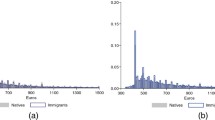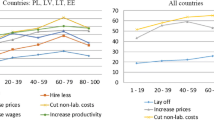Abstract
How will the commitment to price stability affect labour market rigidities in the European Monetary Union? I explore a model where firms choose between fixed wage contracts (where the employer cannot lay off the worker, and the wage can only be changed by mutual consent), or contracts where employment is at will, so that either party may terminate employment (with strong similarities to temporary jobs). A fixed wage contract provides better incentives for investment and training, while employment at will facilitates efficient mobility. Inflation erodes the real value of a fixed contract wage over time, and badly matched workers are more likely to quit for other jobs. Disinflation has opposing effects on labour market rigidity: fixed wage contracts become more rigid in real terms, but fewer firms will choose fixed wage contracts.
Similar content being viewed by others
References
Acemoglu, D. and Pischke, J.-S. (1999) ‘Beyond Becker: Training in Imperfect Labour Markets', Economic Journal 109, F112–F142.
Agell, J. and Lundborg, P. (1999) ‘Survey Evidence on Wage Rigidity and Unemployment’, IFAU WP 1999: 2, Uppsala, Sweden.
Akerlof, G.A., Dickens, W.T., and Perry, W.L. (1996) ‘The Macroeconomics of Low Inflation', Brookings Papers on Economic Activity 1, 1–75.
Arulampalam, W. and Booth, A.L. (1998) ‘Training and Labour Market Flexibility: Is There a Tradeoff?', British Journal of Industrial Relations 36, 521–536.
Bean, C. (1998) ‘The Interaction between Aggregate-Demand Policies and Labour Market Reform', Swedish Economic Policy Review 5, 353–382.
Becker, G. (1964) Human Capital, Chicago: The University of Chicago Press.
Bertola, G. (1999) Microeconomic Perspectives on Aggregate Labor Markets, in O.C. Ashenfelter and D. Card (eds), Handbook of Labor Economics, Vol 3C, Elsevier.
Blanpain, R. (ed.) (1994) International Encyclopaedia for Labour Law and Industrial Relations, Deventer: Kluwer Law and Taxation Publishers.
Burgess, S. (1994) ‘The Reallocation of Employment and the Role of Employment Protection Legislation', Centre for Economic Performance DP 193, London.
Cahuc, P. and Postel-Vinay, F. (1999) ‘Temporary Jobs, Employment Protection and Labor Market Performance', Mimeo, Universite Paris 1-Eurequa.
Calmfors, L. (2001a) ‘Unemployment, Labour-Market Reform and Monetary Union', Journal of Labor Economics 19, 265–289.
Calmfors, L. (2001b) ‘Wages and Wage-Bargaining Institutions in the EMU – A Survey of the Issues', Empirica, this issue.
Cukierman, A. and Lippi, F. (2001) ‘Labor Markets and Monetary Union. A Strategic Analysis', Economic Journal 11, 541–565.
Dessy, O. (1999) ‘Wage Rigidity in Italy', University of Southampton working paper.
Franzese, R.J. (2001) ‘Credibly Conservative Monetary Policy and Wage/price Bargaining Organization: A Review with Implications for Monetary Policy in the European Common Currency Area', Mimeo, The University of Michigan.
Gordon, R.J. (1996) ‘Comment on Akerlof et al. (1996). The Macroeconomics of Low Inflation', Brookings Papers on Economic Activity 1, 60–66.
Holden, S. (1994) ‘Wage Bargaining and Nominal Rigidities', European Economic Review 38, 1021–1039.
Holden, S. (1999) ‘Renegotiation and the Efficiency of Investment', Rand Journal of Economics 30, 106–119.
Holden, S. (2001a) ‘Monetary Regimes and the Co-ordination of Wage Setting', CESifoWP 429.
Holden, S. (2001b) ‘Monetary Policy and Nominal Rigidities under Low Inflation', Mimeo, University of Oslo.
Larsen, J.D.J (1999) ‘The Macroeconomic Implications of Turnover Costs and Wage Contracts', Mimeo, Bank of England.
Lebow, D.E., Saks, R.E., and Wilson, B.A. (1999) ‘Downward Nominal Wage Rigidity. Evidence from the Employment Cost Index', WP, Board of Governors of the Federal Reserve System.
Lindbeck, A. and Snower, D. (1988) The Insider-Outsider Theory of Employment and Unemployment, Cambridge, MA: MIT Press.
MacLeod, W.B. and Malcomson, J.M. (1993) ‘Investment, Holdup, and the Form of Market Contracts', American Economic Review 37, 343–354.
MacLeod, W.B. and Malcomson, J.M. (1998) ‘Motivation and Markets', American Economic Review 88, 388–411.
Malcomson, J.M. (1997) ‘Contracts, Hold-Up, and Labor Markets', Journal of Economic Literature 35(4), 1916–1957.
Mankiw, N.G. (1996) ‘Comment on Akerlof et al. (1996). The Macroeconomics of Low Inflation', Brookings Papers on Economic Activity 1, 66–70.
OECD (1999). Employment Outlook, June. Paris.
Smith, J.C. (2000) ‘Nominal Wage Rigidity in the UK', The Economic Journal 110, C176–C195.
Soskice, D. and Iversen, T. (1998) ‘Multiple Wage-Bargaining Systems in the Single European Currency Area', Oxford Review of Economic Policy 14, 110–124.
Tobin, J. (1972) ‘Inflation and Unemployment’, American Economic Review 62, 1–18.
Williamson, O.E. (1985) The Economic Institutions of Capitalism, New York: Free Press.
Author information
Authors and Affiliations
Rights and permissions
About this article
Cite this article
Holden, S. Does Price Stability Exacerbate Labour Market Rigidities in the EMU?. Empirica 28, 403–418 (2001). https://doi.org/10.1023/A:1013932912812
Issue Date:
DOI: https://doi.org/10.1023/A:1013932912812




